
Mobile is a city and the county seat of Mobile County, Alabama, United States. The population within the city limits was 187,041 at the 2020 census, down from 195,111 at the 2010 census. After a successful vote to annex areas west of the city limits in July 2023, Mobile's population increased to 204,689 residents. It is now the second-most-populous city in Alabama, after Huntsville.

Spring Hill College is a private, Jesuit college in Mobile, Alabama. It was founded in 1830 by Michael Portier, Bishop of Mobile. Along with being the oldest college or university in the state of Alabama, it was the first Catholic college in the South, is the fifth-oldest Catholic college in the United States, and is the third-oldest member of the Association of Jesuit Colleges and Universities.
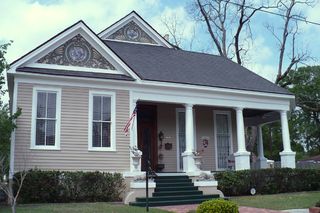
The Leinkauf Historic District is a historic district in the city of Mobile, Alabama, United States. It was placed on the National Register of Historic Places on June 24, 1987. It is roughly bounded by Government, Eslava, Lamar, and Monterey Streets. The district covers 1,100 acres (4.5 km2) and contains 303 contributing buildings. The buildings range in age from the 1820s to early 20th century and cover a variety of 19th- and 20th-century architectural styles.

The Ashland Place Historic District is a historic district in the city of Mobile, Alabama, United States. The neighborhood gained its name from a Greek Revival antebellum house called Ashland that once stood on Lanier Avenue. Ashland was famous as the home of Augusta Evans Wilson. The house burned in 1926. The Ashland Place Historic District was placed on the National Register of Historic Places on June 23, 1987. It is roughly bounded by Spring Hill Avenue, Ryan Avenue, Old Shell Road, and Levert Avenue. The district covers 400 acres (1.6 km2) and contains 93 contributing buildings. The majority of the buildings date to the early 20th century and cover a variety of historical architectural styles ranging from late Victorian to the Craftsman styles.

The Campground Historic District, also known as The Campground is a historic district in the city of Mobile, Alabama, United States. Named for the Old Camp Ground, a military encampment that occupied the property during the American Civil War, this historically African-American neighborhood was placed on the National Register of Historic Places on July 7, 2005. It is roughly bounded by Martin Luther King Jr. Avenue, Rylands Street, St. Stephens Road, and Ann Street. The district covers 370 acres (1.5 km2) and contains 166 contributing buildings. The houses range from shotgun houses to bungalows and date from the late 19th century to the middle 20th century.

The Bettie Hunter House is a historic African American residence in Mobile, Alabama, United States. It was the residence of Bettie Hunter, a former enslaved African who grew wealthy from a successful hack and carriage business she operated in Mobile with her brother, Henry. The fall of New Orleans during the American Civil War had made Mobile the South's only major port on the Gulf of Mexico. Transportation of goods to and from the port depended on the city's teamsters and their horse or mule-drawn wagons. Bettie Hunter was part of a group of African Americans who recognized the opportunities in the carriage business and she cornered this part of the transportation market in Mobile.
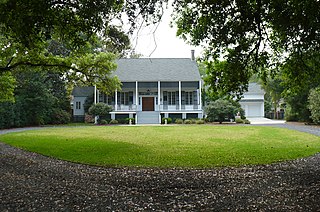
The Beal–Gaillard House is a historic house located at 111 Myrtlewood Lane in Mobile, Alabama. It is locally significant as an excellent example of a large country home constructed before the widespread use of highly sophisticated moldings and columnar orders.

The Collins–Robinson House is a historic residence in Mobile, Alabama. It was built in 1843 in a Creole cottage style. It was placed on the National Register of Historic Places on October 18, 1984, as a part of the 19th Century Spring Hill Neighborhood Thematic Resource.

Saint Paul's Episcopal Chapel is a historic Episcopal church building in Mobile, Alabama, United States. It was built in 1859 in a vernacular Gothic Revival style. The building was placed on the National Register of Historic Places as a part of the 19th Century Spring Hill Neighborhood Thematic Resource on October 18, 1984.

The Sodality Chapel is a historic Roman Catholic chapel building on the campus of Spring Hill College in Mobile, Alabama, United States. It was built in 1850 in a simple Greek Revival style. The building was placed on the National Register of Historic Places as a part of the 19th Century Spring Hill Neighborhood Thematic Resource on October 18, 1984.
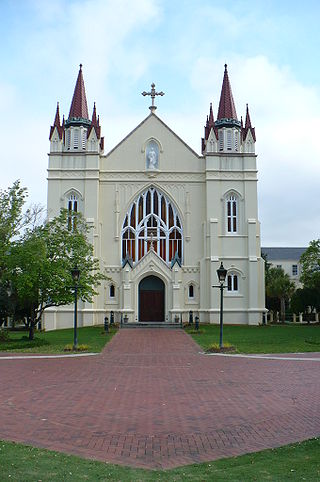
The Spring Hill College Quadrangle is a grouping of historic structures on the campus of Spring Hill College in Mobile, Alabama, United States. The original main building was constructed in 1831 in the Greek Revival style, but burned in 1869. It was replaced within the year by a new main building on the same site in a Neo-Renaissance style. St. Joseph's Chapel was built c.1910 in the Gothic Revival style on the northern side of the quadrangle, with the main building on the southern side. The perimeter of the quadrangle is enclosed by an open arched arcade, topped by crenellation. The grouping was placed on the National Register of Historic Places on August 17, 1973.

The Cavallero House is a historic residence in Mobile, Alabama. It was built in 1835 in the Federal style. A cast-iron gallery was added in the mid-19th century. The house was added to the National Register of Historic Places on October 7, 1982. In addition to be individually listed in the National Register, the house is also a contributing building to the Lower Dauphin Street Historic District.

The Denby House is a historic raised cottage in Mobile, Alabama. The one-story brick house was built by Charles Denby in 1873. It was added to the National Register of Historic Places on January 5, 1984. In addition to being listed individually on the National Register of Historic Places, it is also a contributing building to the Lower Dauphin Street Historic District.

The Center–Gaillard House is a historic residence in Mobile, Alabama. The earliest part of the house was built in 1827. It was placed on the National Register of Historic Places on October 18, 1984, as a part of the 19th Century Spring Hill Neighborhood Thematic Resource.
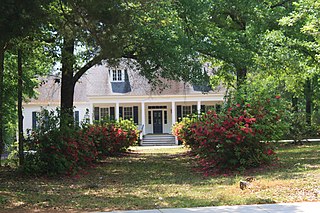
The Collins–Marston House is a historic house located at 4703 Old Shell Road in Mobile, Alabama.

The Emanuel Building, also known as the Bank of Mobile and Staples-Pake Building is a historic commercial building in Mobile, Alabama, United States. The three-story masonry structure was built in 1850 and then remodeled several times over the next century. It was placed on the National Register of Historic Places on March 21, 1978.
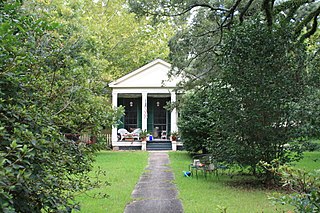
The Amelia Stewart House, also known as the Carol O. Wilkinson House and William Hallett House, is a historic residence in Mobile, Alabama, United States. It was built in 1835, with a significant Greek Revival style addition to the front built in 1871. The house was placed on the National Register of Historic Places on May 29, 1992, based on its architectural significance.

The Pfau–Crichton Cottage, best known as Chinaberry, is a historic cottage in Mobile, Alabama. The 1+1⁄2-story, wood-frame, Gulf Coast cottage was completed in 1862. The house was built by the Pfau family, but its best known resident was Miss Anne Randolph Crichton, known for the elaborate gardens that she developed on the property. She enlisted in the Navy at the outbreak of World War I and continued her service until retirement, in the 1950s. She traveled extensively in Europe during the 1930s, maintaining scrapbooks that recorded her visits to various art museums, gardens, and monuments. She was the last direct descendant of Hugh Randolph Crichton, the founder of the Mobile County town of Crichton. The house was added to the National Register of Historic Places on October 18, 1984, as a part of the 19th Century Spring Hill Neighborhood Thematic Resource listing of well-preserved buildings that represent the historical development of what was once the village of Spring Hill.
The 19th Century Spring Hill Neighborhood Thematic Resource is a multiple property submission of buildings that were listed together on the National Register of Historic Places. It covers eight properties in the Spring Hill neighborhood of Mobile, Alabama, all built during the mid-19th century.

Spring Hill is a neighborhood of Mobile, in Mobile County, Alabama. Located on a tall broad hill 6 miles (10 km) to the west of downtown Mobile, it has one of the highest elevations in the area. Originally a summer retreat community, it was eventually encompassed and annexed by the City of Mobile after 1820. It gained its name from a number of natural springs at the site.

























